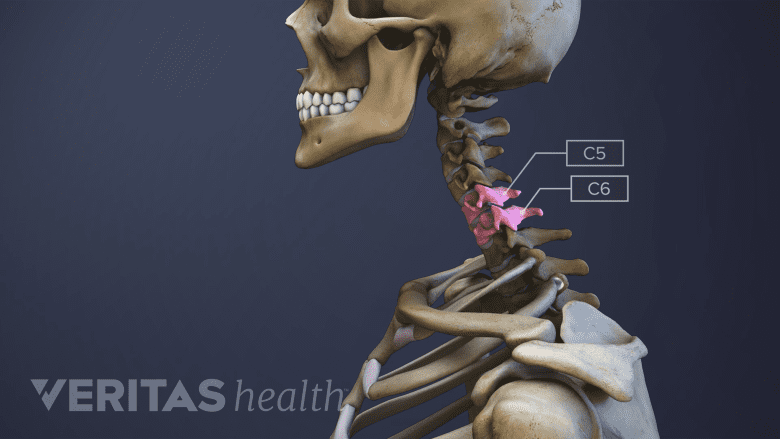A healthy cervical spine has a natural lordotic curve, which gently curves forward from the base of the skull and then backward into the top of the chest/upper back. When the head drifts forward in poor posture:
- The lower cervical spine goes into hyperflexion with the lordosis curve flattening out.
- The upper cervical spine goes into hyperextension with the lordosis curve becoming more pronounced.
This unnatural, forward positioning of the head and cervical spine places additional stress on the intervertebral discs, vertebrae, and facet joints, which may exacerbate or accelerate spinal degeneration. Additionally, as the bottom the cervical spine hyperflexes forward and the top of the cervical spine hyperextends in the opposite direction, the spinal canal lengthens through the neck, which increases stretching and tension on the spinal cord and nearby nerve roots.
In This Article:
- How Poor Posture Causes Neck Pain
- Forward Head Posture’s Effect on Neck Muscles
- Forward Head Posture’s Effect on the Cervical Spine
- How to Measure and Fix Forward Head Posture
- Workplace Ergonomics and Neck Pain
How Forward Head Posture Stresses the Lower Cervical Vertebrae

With forward head posture, the compressive forces increase at the C5-C6 segment.
The lower part of the neck, just above the shoulders, is particularly vulnerable to pain caused by forward head posture. The lower cervical vertebrae, including C5, C6, and C7, already handle the most load from the weight of the head. As the head is held further forward, this load only increases.
With forward head posture, some studies suggest that the compressive forces typically increase the most at the c and C5-6 spinal levels.1Gray JC, Grimsby O. Interrelationship of the spine, rib cage, and shoulder. In: Donatelli RA. Physical Therapy of the Shoulder. 5th ed. London: Churchill Livingstone; 2012: 87-130. The intervertebral discs and facet joints at these spinal levels may be subject to additional shearing forces with the vertebrae being pulled in different directions relative to one another, as well as repetitive traumas that can cause pain and other symptoms.
While the lower cervical spine may experience greater loads with forward head posture, it should also be noted that compressive forces are increased on all of the discs and joints throughout the cervical spine. Furthermore, the specific cervical levels that experience the largest increase in compressive loads can vary from person to person.
Forward Head Posture and Degenerative Spinal Changes

Over time, poor posture can cause the facet joint’s cartilage to wear down.
As the body naturally ages, it is normal for some degenerative spinal changes to occur. Long-term forward head posture, however, may increase the risk for accelerated degenerative spinal changes, such as:
- Disc degeneration. Intervertebral discs play an important role in cushioning adjacent vertebral bones and facilitating spinal mobility. When subjected to increasing loads and shearing forces between adjacent vertebrae, discs must do more work and may degenerate sooner. In some cases, the outer layer (annulus fibrosus) of the disc wears down and the inner layer (nucleus pulposus) leaks out, which contains inflammatory proteins that can cause pain and swelling if they come in contact with nerve roots or other nearby tissues (called a cervical herniated disc).
- Wearing down of facet joints. The small facet joints located at the back of each spinal level permit limited motion between adjacent vertebrae. When these joints are subjected to greater loads and repeated traumas, the protective cartilage that facilitates smooth motions between these bones can wear down. When cartilage begins breaking down within a cervical facet joint, the condition is called cervical osteoarthritis.
- Bone grinding against bone. As the discs and/or facet joints degenerate, vertebral bones are more likely to rub directly against each other, which leads to bony overgrowths, called bone spurs (osteophytes). Bone spurs can further irritate nearby structures, such as nerves, ligaments, muscles, and others.
Degenerative changes to the cervical intervertebral discs are commonly accompanied by degenerative changes to the cervical facet joints. Typically, as a disc starts to degenerate, the nearby facet joints become overloaded and also start to degenerate. Likewise, as a facet joint degenerates, the nearby discs may also be subjected to increased forces.
See 3 Ways to Improve Forward Head Posture
Forward Head Posture and Cervical Spine Symptoms

Cervicogenic headache is a long-term consequence of poor neck posture.
Long-term forward head posture can play a role in numerous symptoms that stem from the cervical spine, including:
- Neck pain and/or upper back pain that can range anywhere from general soreness to intense, sharp pain. This pain may also spread into the shoulder(s).
- Cervicogenic headache, which involves the upper cervical spine referring pain up into the head.
- Cervical radiculopathy symptoms of pain, pins-and-needles tingling, numbness, and/or weakness radiating into the shoulder, arm, hand, and/or fingers.
It is possible for these symptoms to be present with or without forward head posture. Even in cases when forward head posture is not the primary cause of neck pain and related symptoms, it can still worsen these symptoms.
- 1 Gray JC, Grimsby O. Interrelationship of the spine, rib cage, and shoulder. In: Donatelli RA. Physical Therapy of the Shoulder. 5th ed. London: Churchill Livingstone; 2012: 87-130.

